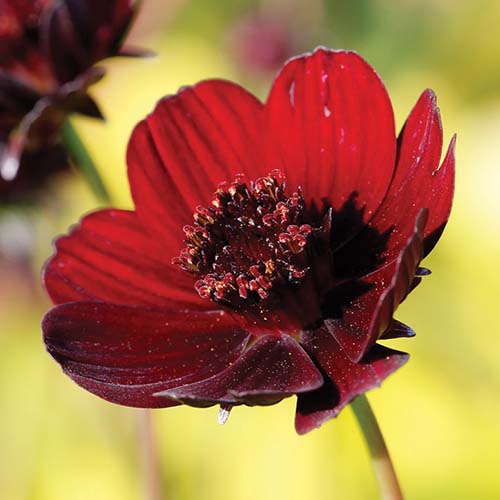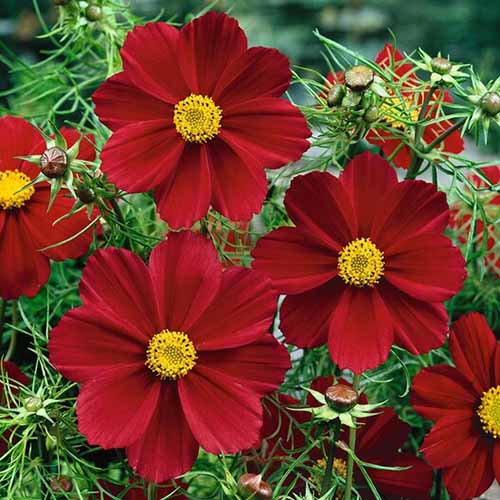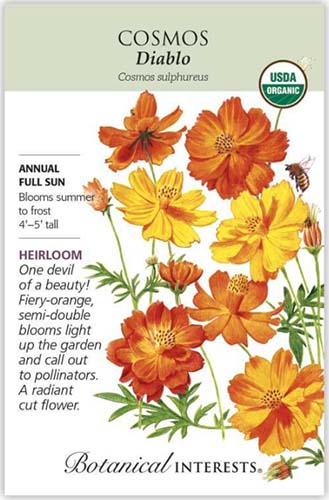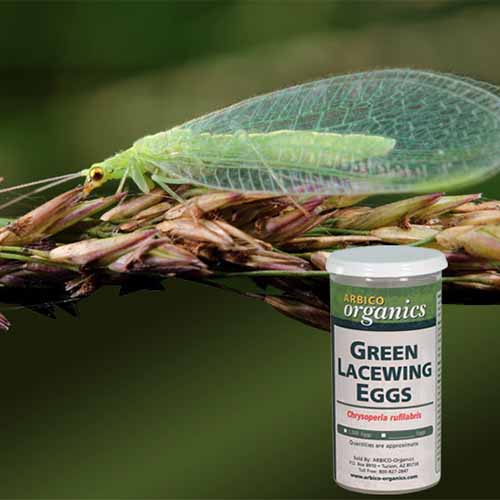How to Grow and Care for Cosmos Flowers

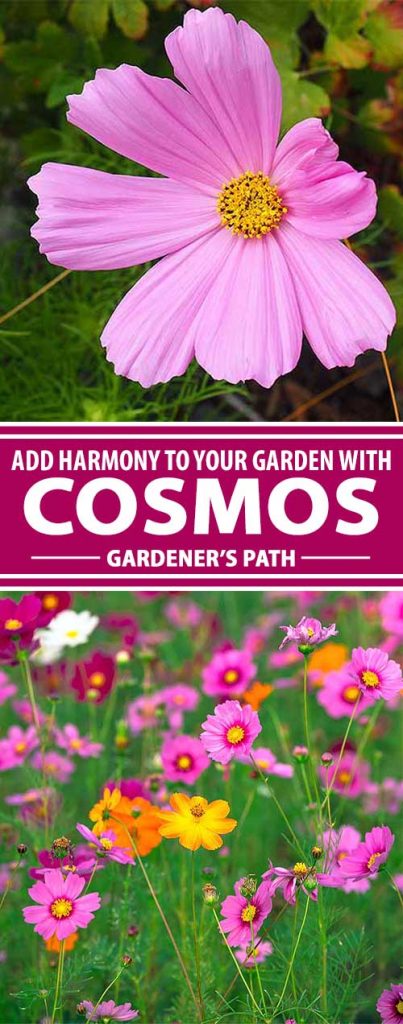
Cosmos spp.
Cosmos flowers are gorgeous ornamental plants that flourish in less than ideal conditions.
A boon to pollinators and other beneficial insects, these plants are a welcome addition to both the flower bed and the organic veggie garden.
If your garden universe doesn’t include this annual, perhaps it should! This easy-care plant thrives on sun and heat, offering glorious color in return.
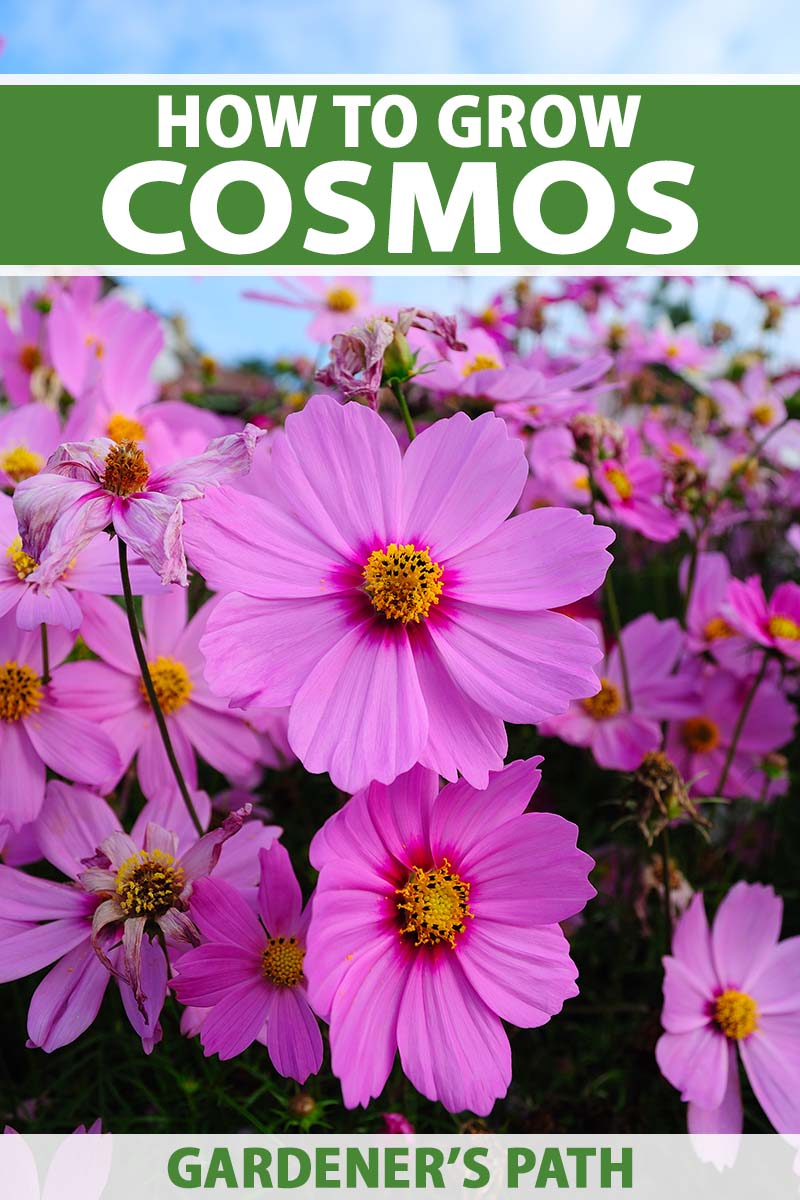

We link to vendors to help you find relevant products. If you buy from one of our links, we may earn a commission.
When I create my summer garden, I like to add elements that make it feel like a peaceful oasis and that are very low maintenance.
Cosmos flowers fit both of these requirements perfectly – they don’t require much care, but wow, do they ever make the garden feel like a haven of life and beauty!
In fact, one of my favorite ways to relax on summer days is to watch bees, butterflies, and even hummingbirds foraging from the showy blooms on my cosmos plants.
Sweetening the deal, these gorgeous flowers produce loads of blooms from early summer all the way up until the first fall frost.
In this article you’ll learn everything you’ll need to know to grow these lovely flowers – so that, if you choose, they can become one of your summer highlights too.
Here’s what we’ll cover:
What You’ll Learn
What Are Cosmos?
Cosmos are herbaceous plants cultivated for their gorgeous flowers. They’re most often grown as summer annuals.
These flowers are available in a wide assortment of cultivars comprising many different colors and featuring different types of blooms.
Blooms are held on tall, branching stems, while flowers have petals in shades of pink, purple, white, lavender, red, orange, or yellow, as well as bicolors, which are beautifully spaced around a central disk.
Of the 20 or so species in the Cosmos genus, two of these are commonly grown in home gardens.
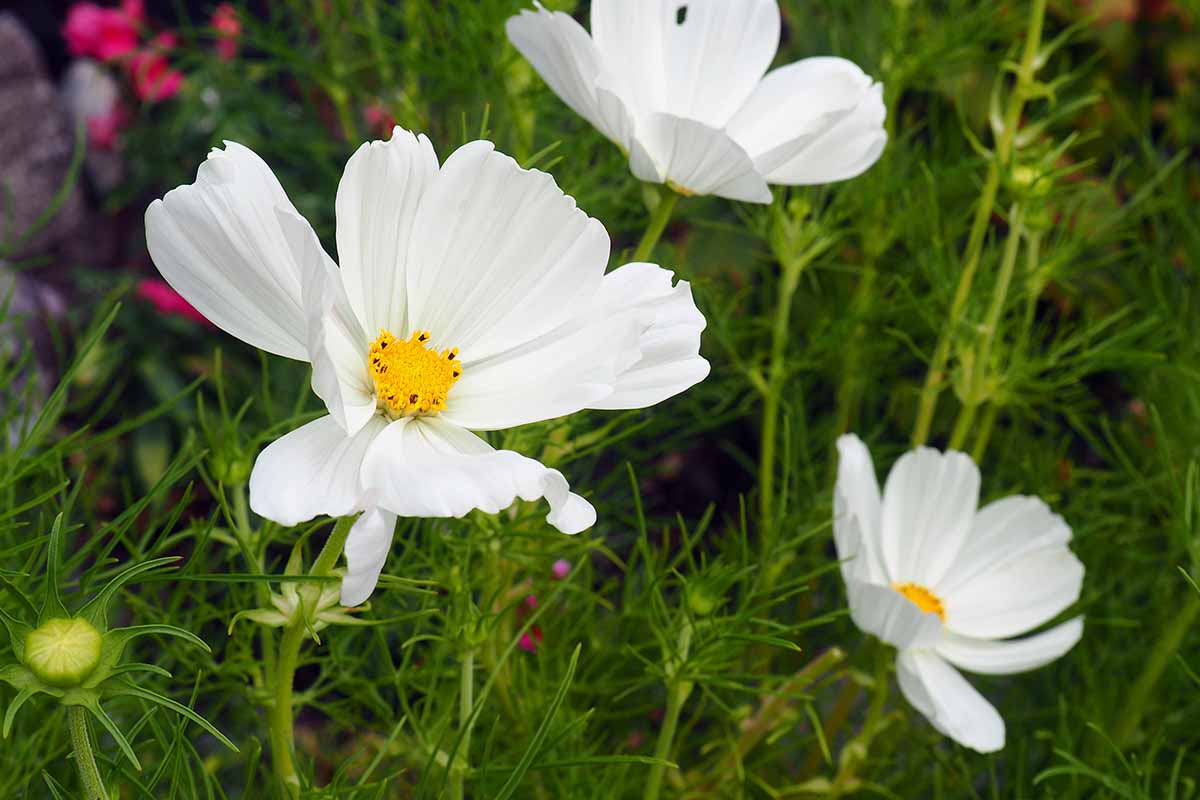

C. bipinnatus, also known as “garden cosmos,” is most often sold in a mix of white, pink, purple, and burgundy. The foliage is delicate and wispy, and bloom colors tend toward cool shades.
C. sulphureus, also known as “sulfur cosmos,” comes in warm shades of yellow, orange, and red and has foliage that you might mistake for marigold or chrysanthemum leaves.
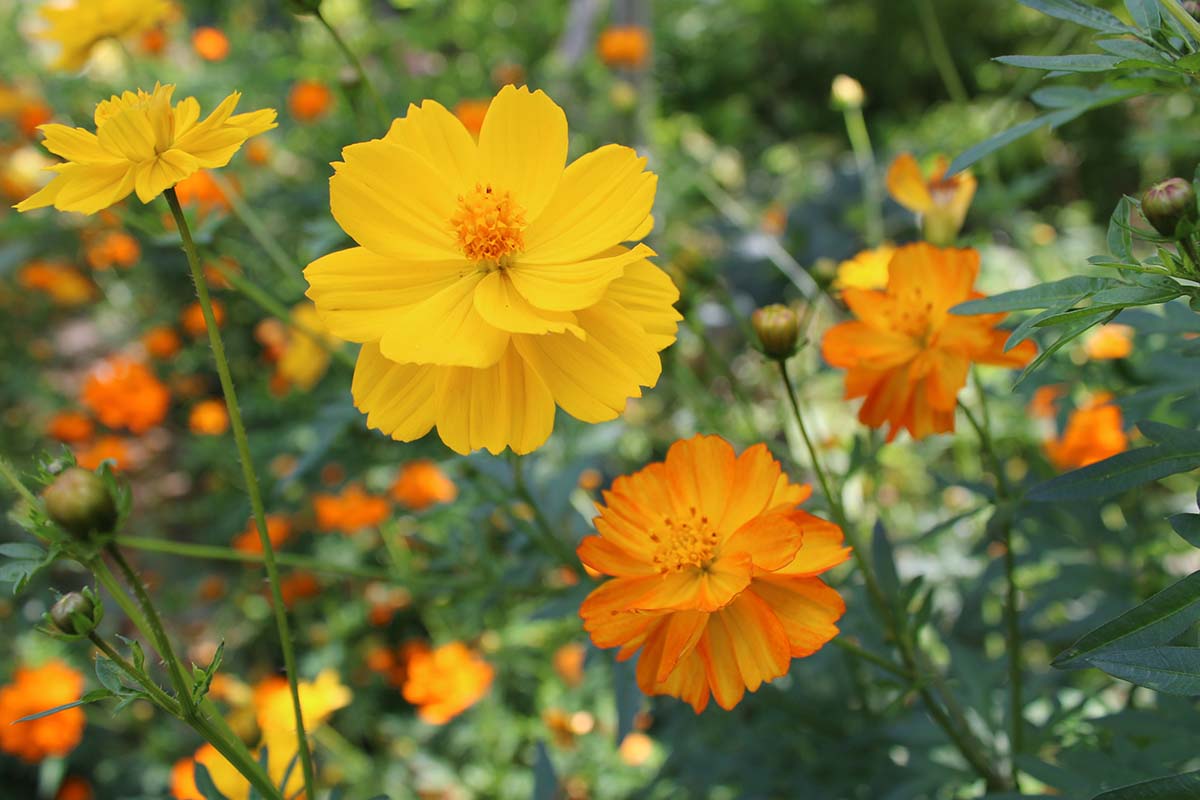

A third species that is somewhat less common in the garden landscape is C. atrosanguineus, also known as “chocolate cosmos.”
You’ll learn more about these species and their cultivars – as well as some tips on where to purchase them – later in this article, so keep reading!
Cultivation and History
Plants in the Cosmos genus are native to the Americas, ranging from Washington State in the Pacific Northwest of the United States all the way to South America.
However, the three species most commonly cultivated in gardens are all native to Central America.
These plants belong to the huge Asteraceae family, and are related to other garden beauties such as coneflowers, dahlias, and marigolds.
The genus Cosmos takes its name from the Greek word “kosmos,” a word with many different translations, ranging from “adornment” to “universe.” In the case of this flower, the word is best translated as something akin to “beauty.”


These lovely flowers have been used and enjoyed by humans for many centuries, if not longer.
According to T. K. Lim, author of “Edible Medicinal and Non-Medicinal Plants,” Volume 7, which is available on Amazon, pre-Columbian civilizations in Latin America used the orange or yellow flowers of C. sulphureus to produce dye.
Later, explorers imported cosmos seeds into Spain, and in the late 1700s, botanist Casimiro Gomez de Ortega brought C. bipinnatus from Spain to England.
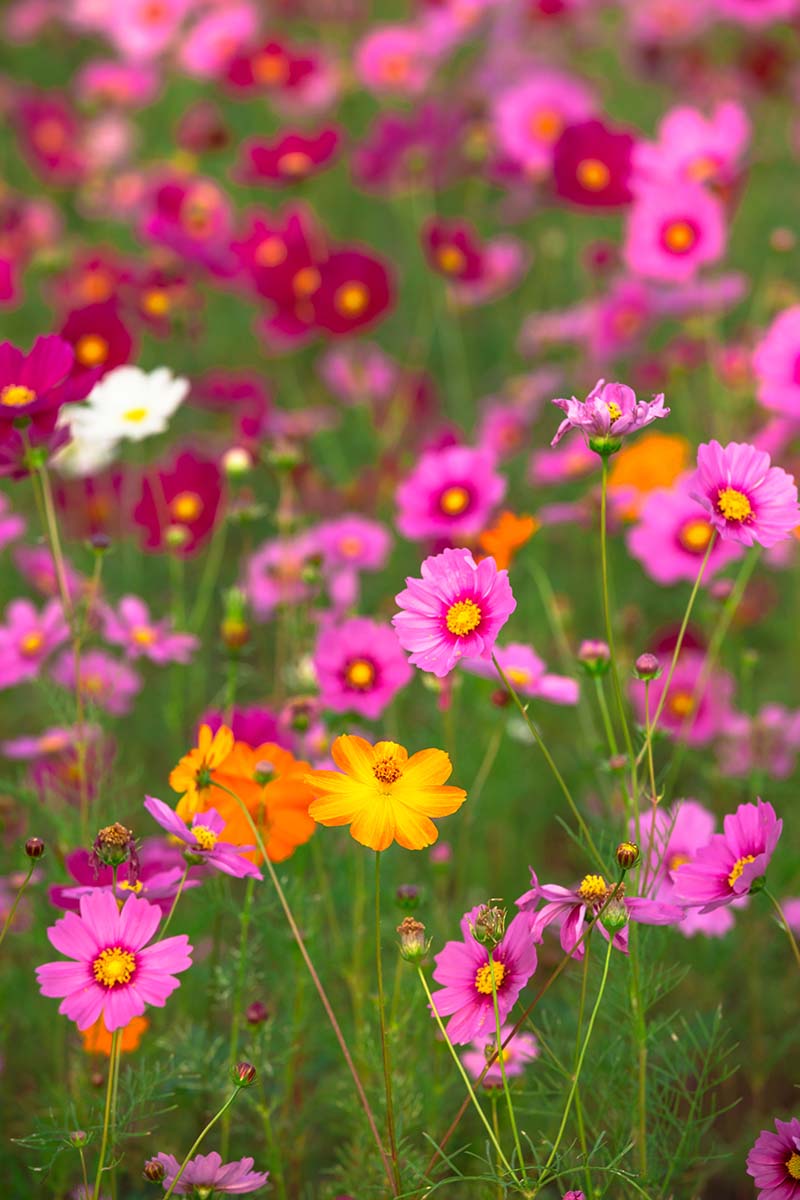

Although they are most commonly referred to by their genus name, these flowers are also known by the common name “Mexican asters.”
In most parts of the United States, Mexican asters are considered annuals, though gardeners in USDA Hardiness Zones 9 and 10 can treat them as perennials.
Propagation
You can propagate garden and sulfur cosmos by sowing them directly into the soil, or by starting them indoors and transplanting out the seedlings. For chocolate cosmos, the most reliable propagation method is to divide tubers.
Outdoors from Seed
Garden and sulfur cosmos are extremely easy to grow from seed, so if you are a beginning gardener (or just revisiting some of the basics) these are excellent flowers to start with.
In fact, these seeds germinate so easily that they tend to self-sow, growing back from seed year after year, and they are known for becoming a bit weedy.
(However, I must point out that a plant’s status as a “weed” is entirely up to one’s point of view. I look at cosmos volunteers not as “weeds” but as welcome “bonus” blooms.)
Does it sound like I’m digressing? I’m trying to make a point about growing these flowers from seed, and you’ll see where I’m going in just a moment, so bear with me…


Before you start sowing, you’ll want to know the best time to plant these seeds.
And now we’re coming to the point. Every other source you consult will most likely recommend waiting to sow cosmos seeds until after the last average spring frost for your location.
However, I’m not one to follow horticultural advice to the letter while ignoring what’s transpiring in my own garden, or the veggie plots and flower beds of many other gardeners.
The number of volunteer cosmos seedlings that sprout before the last spring frost every year and survive to brandish their glory throughout the summer are proof that waiting may not be necessary.
Taking a cue from what was happening among my volunteers, lately I have started sowing these seeds in early spring along with my cool-weather crops, just to see what would happen.
As I suspected – and much to my delight! – my early-spring-sown seedlings survive light frosts, providing me with early summer blooms, a valuable asset in my region where the growing season is short.


I’ll admit, though, that I consider this approach to sowing warm-season flowers to be an experiment.
So if you want to play it safe, wait until one to two weeks after your last average frost date when the temperature of your soil has reached at least 60 or 70°F.
If you’re willing to take a risk, try planting some of these at the same time as your spring garden seeds. You can always use floating row covers to protect the seedlings if your weather forecast predicts a hard freeze.
When you’re ready to sow, prepare your beds by mixing in some compost, push aside a little soil to use for covering the seeds, then smooth the soil down so it’s level.
Water the soil in with a gardening wand so the soil surface is moist.
Place a group of three seeds every nine to 12 inches, then cover them very lightly with soil. The seeds should only be covered by about 1/16th of an inch.
Expect seedlings to emerge in five to 21 days after sowing.
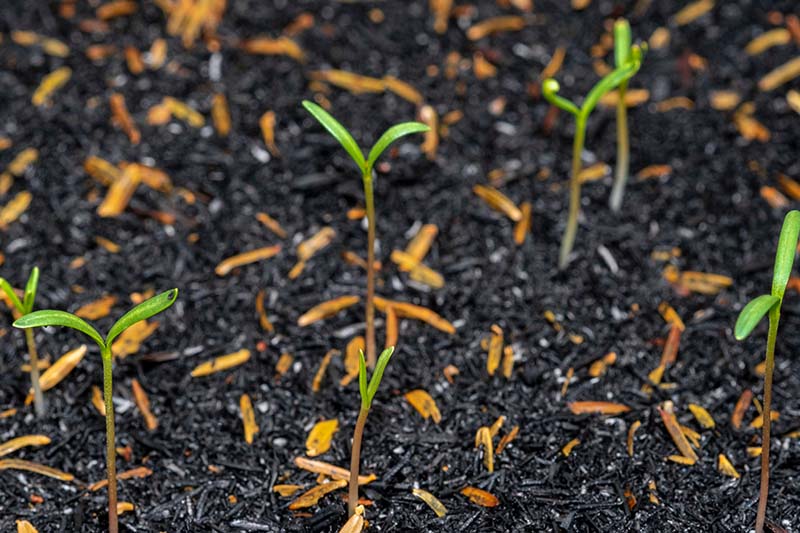

While the seeds are germinating, keep the soil moist, watering daily if needed.
Taper off the frequency of your watering as the seedlings that sprout become established. You’ll learn more about how often to water established plants later in this article.
When the seedlings are a couple of inches tall, thin them so you have only one every nine to 12 inches.
Those of us in colder zones where the ground stays frozen throughout winter might also try pre-seeding our gardens with cosmos seeds in the fall or sowing them in the winter so they come up the following spring.
Both of these methods will expose young seedlings to early spring frosts, so keep your row covers at the ready in case any hard frosts are forecasted.
Indoors from Seed
If the early sowing method I just described sounds a little too risky for your taste but you still want to get a head start on summer, you can sow these seeds indoors and then transplant them out after your last spring frost.
You’ll want to get the timing right when using this method so you don’t end up with plants that are too big to manage indoors when the weather is still frigid outside.
Plan to sow seeds indoors four to six weeks before your last average frost date.


For indoor sowing, you’ll need a sterile seed-starting medium, two-inch pots or six-celled seed starter trays, a spray bottle, and of course, seeds for the varieties of your choice. You may also want to use a grow light and a heat mat.
Fill the pots or cells with growing medium, leaving about half an inch to an inch of space between the surface of the soil and the rim of the pot. This way, you’ll have room to water without spilling soil over the edge.
Spray the growing medium with water to moisten it without allowing it to become soggy. Place one to three seeds in the center of the pot or in each cell, cover them very lightly with soil, then spray the surface of the soil with the water bottle.
If you have a very bright south-facing window, you can grow your seedlings next to this light source. Alternatively, you may want to consider using grow lights, which will give the seedlings the light they need and prevent them from becoming leggy.
If using sunlight as a light source, rotate the pots daily to prevent lopsided growth.
Keep the surface of the soil moist, watering daily with your spray bottle if needed.
Ideally, keep the seeds warm while they’re germinating, at a temperature of at least 60°F.
To keep them warm, try using a heat mat, such as the Jump Start heat mat, available for purchase in a few different sizes on Amazon.
Look for seedlings to emerge anywhere from five days after sowing up to 21 days.
Once the seedlings size up and when the soil begins to dry out more quickly, switch from watering with a spray bottle to using a houseplant-adapted watering can, which will provide good control over where the water flows.
If more than one seedling has germinated in each pot or cell, thin the weakest-looking seedlings by snipping them off with a pair of scissors.
You can transplant the seedlings one to two weeks after the last frost, but be sure to check your weather forecast first for any dips in the temperature.
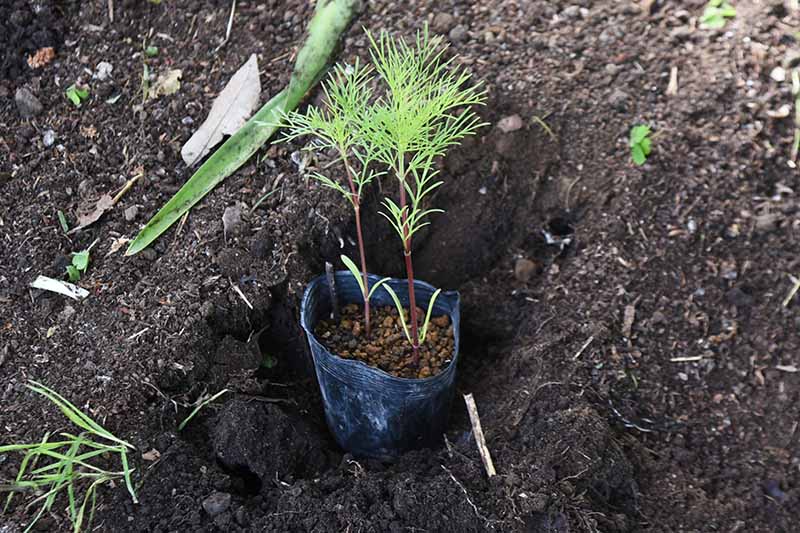

While direct-sown seeds may have some resistance to light frosts, don’t count on that protection for seedlings grown indoors. These hothouse flowers will be much more vulnerable and not yet able to put up with extreme weather fluctuations.
Harden seedlings off before transplanting to help them build up some resilience.
You can find guidance on hardening off and planting transplants in our complete guide to starting annuals indoors.
From Division
Propagation via division is only appropriate to use for C. atrosanguineus, the species commonly called “chocolate cosmos,” which doesn’t grow reliably from seed.
To divide this species, you can follow the same procedure as you would for dividing perennials.
You can learn more about the propagation of C. atrosanguineus, as well as specific growing and care recommendations, in our complete guide to growing chocolate cosmos. (coming soon!)
How to Grow
This summer annual is easy to grow and doesn’t require any coddling. In fact, giving it too much love might cause problems.
Here’s what you need to know in order to provide these flowers with the best possible care:
Sun
These plants should be grown in full sun. That’s to say, they should receive at least six to eight hours of direct sunlight.


If summer heat is extreme in your location, a bit of shade can help, particularly afternoon shade. Just make sure that they get their full quota of sunlight.
Water
When seedlings are young, they will require more frequent watering.
However, once plants are established, they have only moderate water needs, with sulfur cosmos requiring even less water than other varieties.
In fact, overwatering can result in plants with fewer blooms.
So when it comes to irrigating these flowers, water infrequently but deeply, preferably showering the surface of the soil rather than the tops of the plants in the absence of rain.
These annuals are fairly drought tolerant, but during hot summer weather, look for wilting as a sign to increase watering.
Soil
These low-maintenance plants grow best in sandy or loamy soil with a pH ranging between 6.0 and 8.0. The soil should have excellent drainage.
Overly rich soil can cause plants to become leggy and droop over, so this is truly a case where too much love won’t win you any favors.
Growing Tips
- Plant in full sun.
- Water deeply but infrequently.
- Grow in well-draining, sandy or loamy soil.
Pruning and Maintenance
Cosmos plants require very little maintenance, especially if you don’t mind seeing dead flower heads mixed in among the blooms. Here’s what you need to know:
Weeding
While young plants are getting established, weeding around the small fern-like seedlings can help so they won’t be crowded out.
If weeding seems to take up too much of your gardening time, be sure to read our article on how to spend less time weeding.
However, keep in mind that once cosmos are well-established, they won’t be impacted as much by neighboring weeds.
Fertilizing
Fertilizing is another point where too much love can cause problems for these members of the aster family.
Giving them too much help in the way of fertilizer can make them overly tall and lanky.
Instead of fertilizing them during the growing season, just mix some compost into the soil before you sow your seeds or set in your transplants, and your fertilizing is done!
If you offer these plants nothing but compost, they’ll be fine. But if you introduce any other amendments, be aware that fertilizers heavy in the plant nutrient nitrogen will encourage the production of foliage, but not flowers.
Mulching
Mulching around these annuals will help prevent water loss from the soil and extend the time in between watering visits.
Place mulch about two to three inches thick, taking care to leave a couple of inches bare around the stems of these plants, to avoid creating conditions where fungal pathogens could flourish.
And when it comes to mulch, think beyond wood chips and pine straw – there are many other options you can use to cover the soil. Check out our article on mulching to learn more.
Pruning
Cosmos don’t require pruning, so if you are taking a low-maintenance gardening approach like I am, you can skip this part.
However, if you prefer the look of smaller, bushier plants, these can be cut back to a third of their height in midsummer. Just be sure to use sterilized garden pruners to avoid unintentionally spreading disease between plants.
Another reason you might want to do a bit of pruning is if you want to keep spent flower heads off of your plants.
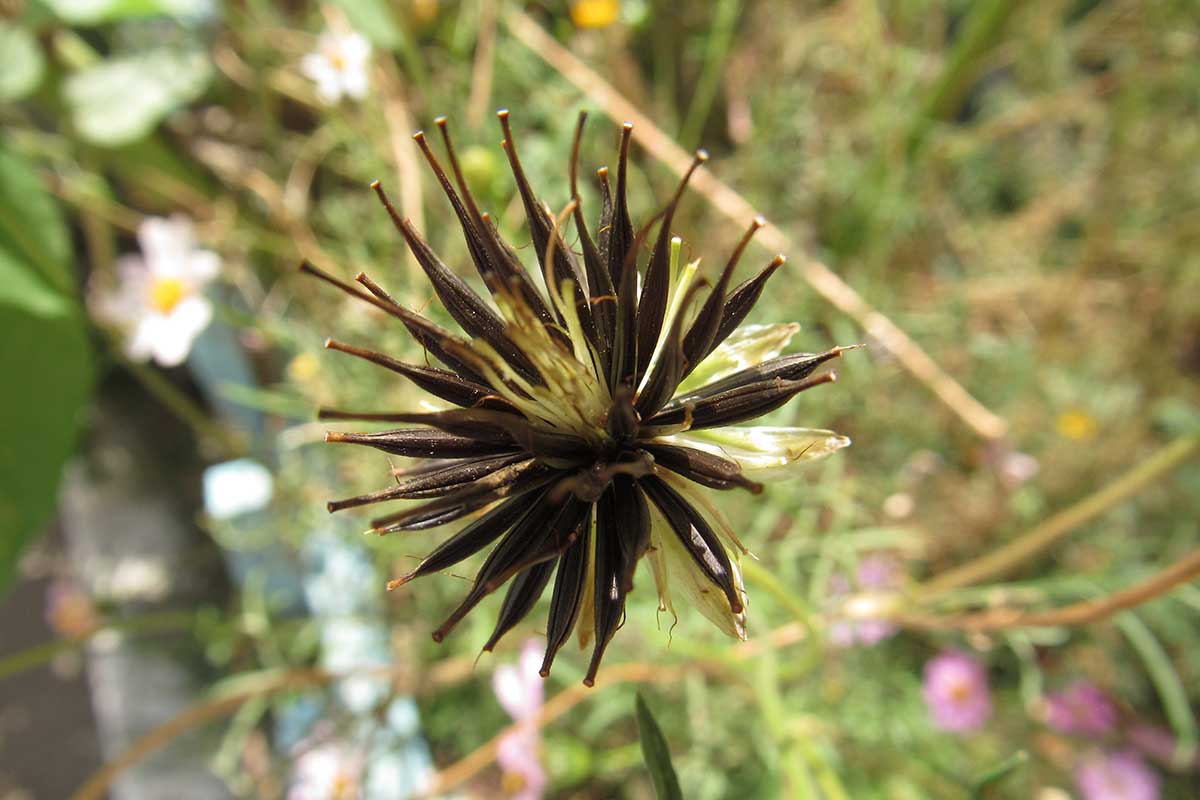

Personally, I love seeing these plants with flowers at all stages of their development – new buds, opening blooms, glorious flowers, and fading petals, finally turning into seed heads.
However, if you don’t like seeing the spent heads or want to prevent re-seeding, you can deadhead them by snipping the faded blooms off with a pair of scissors or garden snips.
Staking
When grown densely in mass plantings, these annuals won’t need any help staying upright – each flower’s neighbors will provide structural support to help keep it from leaning.
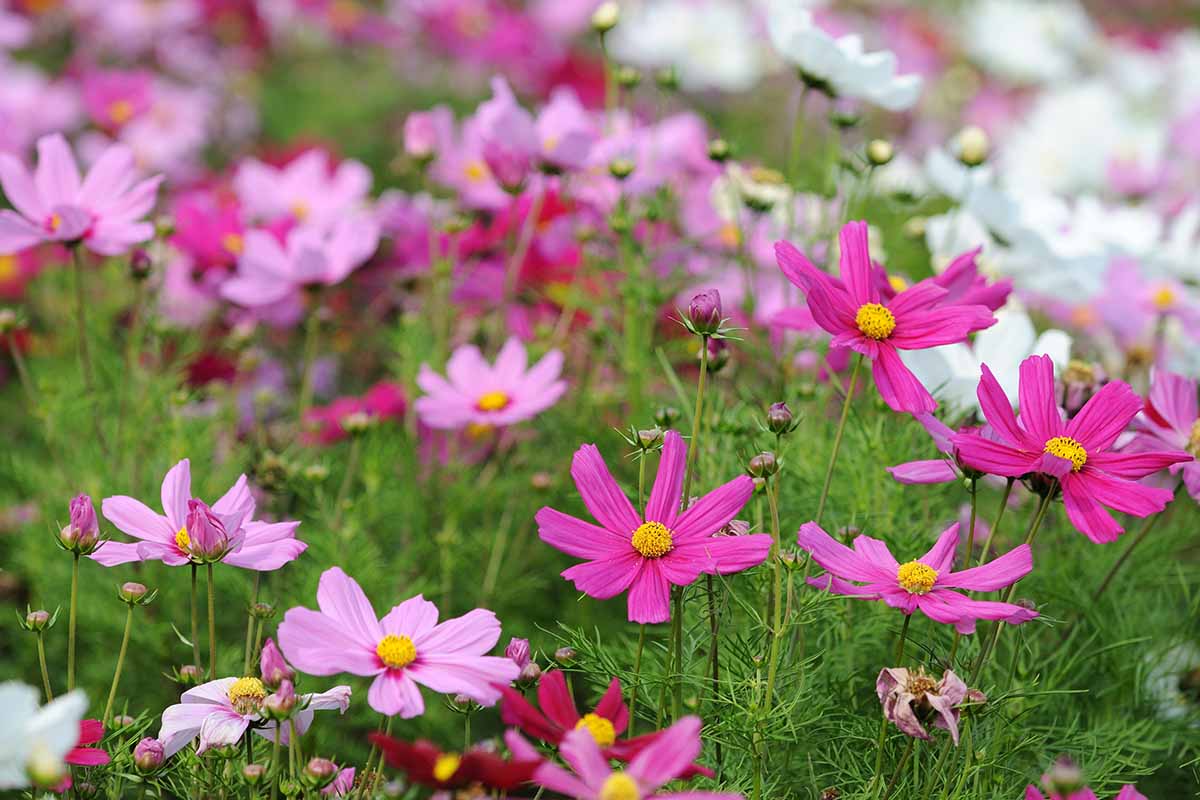

However, if your plantings aren’t quite dense enough to offer structural support, you may want to consider staking these plants.
It’s best to provide support before the plants are eight to 10 inches tall, so you don’t damage their root systems when inserting stakes into the ground.
If you only have a few cosmos plants, you can support each one individually with a bamboo stake and some twine.
However, if you have a large planting of these flowers, you may want to use a staking system similar to that used for tomatoes, such as the Florida weave.
You can read our article to learn how to create your own Florida weave.
Species and Cultivars to Select
As mentioned earlier, there are three main species of Cosmos available to gardeners. We’ll look at the features of each of these, consider their differences, and explore a few cultivars of interest.
Atrosanguineus
Commonly known as “chocolate cosmos,” C. atrosanguineus is a species native to Mexico that has dark, brownish-red blooms with even darker centers.
True to their common name – yes, it’s true! – these one-and-a-half-inch flowers have a chocolatey fragrance. Blooms are single, making them friendly to pollinators.
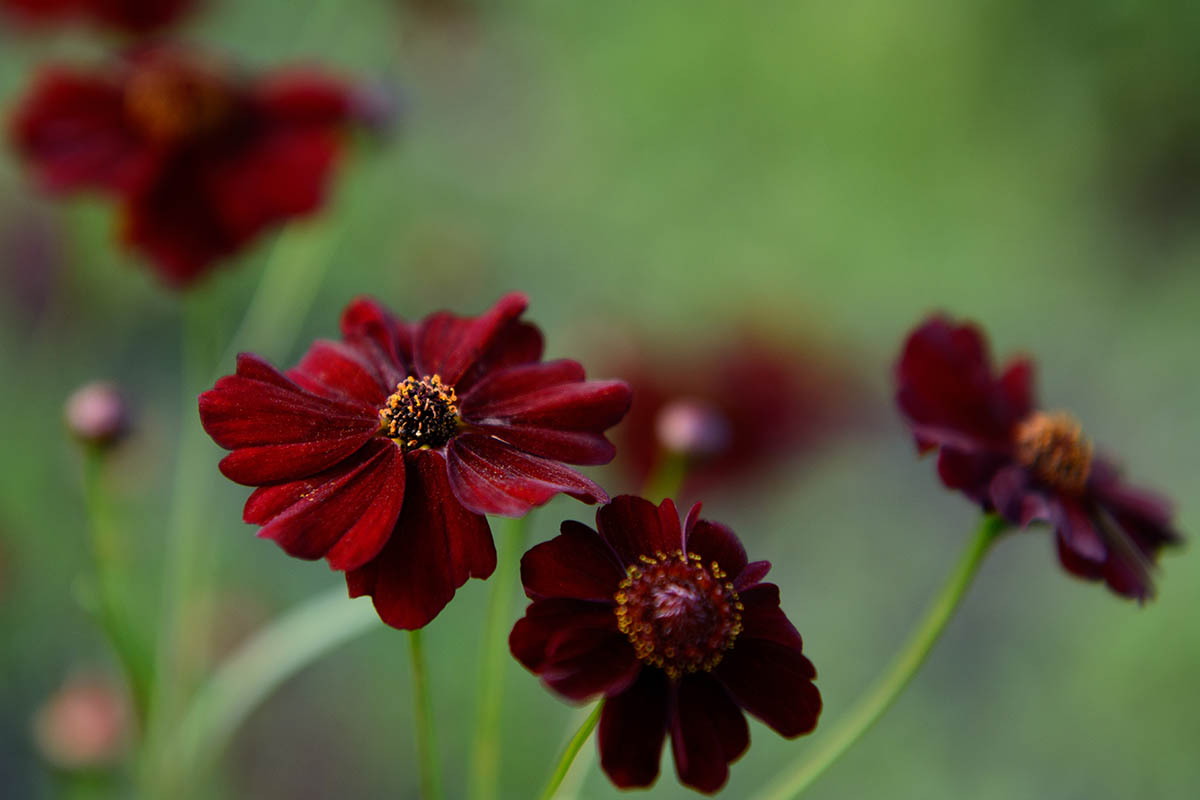

The leaves are small and lance shaped, and the flowers are held on long stems above the foliage, making them wonderful for cut arrangements.
These plants have a mounding growth habit, growing up to 30 inches tall with an 18-inch spread.
Since most varieties of this species don’t have seeds that will germinate reliably, they are typically grown from tubers instead.
C. atrosanguineus is often grown as an annual in Zones 2 to 6, but the tubers can be lifted and stored like dahlias for the winter.
Grown as a perennial in Zones 9 to 11, C. atrosanguineus sometimes survives the winter in Zones 7 and 8 too, if well-mulched.
If you decide to try growing this species from seed, look for the ‘Black Magic’ cultivar. It has viable seeds, but you should expect very low germination rates nonetheless.
Better yet, purchase tubers or live plants to ensure your success.
‘Choca Mocha’ is a petite cultivar of C. atrosanguineus that grows up to 12 inches tall and wide.
You can purchase a live plant ready to transplant into your garden via Burpee.
Bipinnatus
C. bipinnatus is the flower most gardeners tend to think of when they hear the word “cosmos.”
Often referred to as “garden cosmos,” this native of Mexico has wispy, threadlike foliage and flower heads that are two to six inches wide.
Cultivars of this species are available in a huge range of cool-toned colors, including shades of pink, purple, burgundy, yellow, and white.


In addition to this wide range of hues, some intriguing varieties are even bicolored.
Some cultivars have single flowers with wide open petals, while others bear frilly, semi-double flowers, and still others have deeply ruffled double blooms. All of them are magnificent in cut flower arrangements.
Depending on the variety, plants can grow up to six feet tall.
One of my favorite varieties of C. bipinnatus is ‘Versailles Tetra Red.’ This burgundy-hued cultivar reaches up to four feet tall and has two-and-a-half-inch blooms.
You can purchase ‘Versailles Tetra Red’ in packages with enough seeds to cover 80 square feet at Eden Brothers.
Sulphureus
C. sulphureus has a widespread native range across Central America.
Commonly known as “sulfur cosmos,” these usually grow one to three feet tall with a two- to three-foot spread, but some varieties can reach six feet tall.
Blooms are two to three inches wide in shades of red, yellow, gold, and orange. And like milkweed, they attract monarch butterflies.
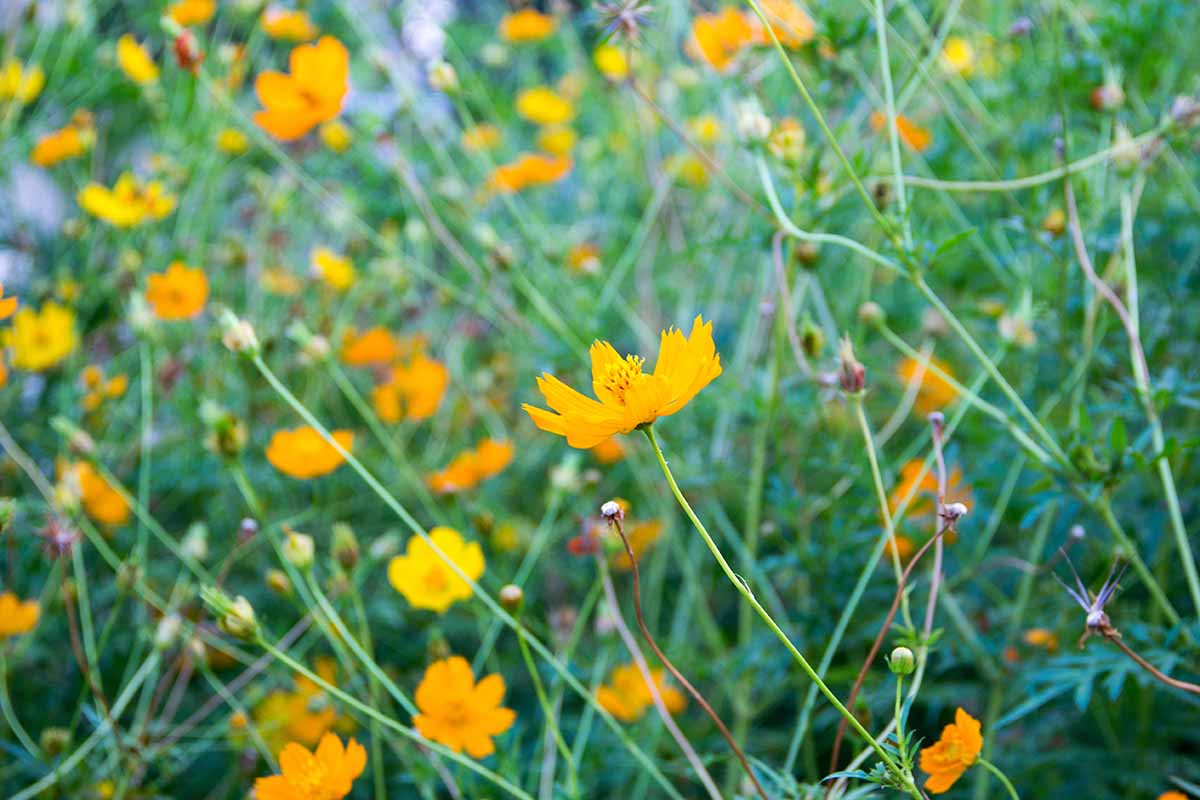

Compared to C. bipinnatus and C. atrosanguineus, sulfur cosmos have shorter stems, making them less desirable as cut flowers.
The branching stems have an open, sprawling growth habit and foliage is green with leaves that are four to eight inches long.
Also known as “yellow cosmos” and “klondike cosmos” the leaves of these plants look similar to marigold or chrysanthemum foliage, and they are not as wispy as the leaves of C. bipinnatus.
‘Diablo’ is a fiery cultivar of C. sulphureus that bears bright, one- to one-and-a-half-inch, reddish-orange blooms on four- to five-foot plants.
An outstanding cultivar, ‘Diablo’ won an All-America Selections award in 1974.
If you’d like to add this warm-hued cosmos variety to your garden, you can find ‘Diablo’ in packets of sixty seeds from Botanical Interests.
This selection of varieties is really just scratching the surface of the myriad of options available. If you’d like to explore more wonderful cultivars, make sure to check out our supplemental guide to 25 of the best cosmos flower cultivars to plant at home.
Managing Pests and Disease
One of the best features of resilient cosmos plants is that they aren’t often troubled by pests or diseases. You can also count them among the many deer-resistant landscaping options you might want to consider.
Here’s a look at some of the pests and ailments you are most likely to encounter:
Pests
Mexican asters are generally pest free, and you are not likely to encounter a problem. However, it’s always good to know what to be on the lookout for in case pests do move into your flower patch.
Aphids
If you notice ants crawling all over your cosmos flowers, take a closer look and see if you spot any aphids as well.
While the activity of the ants will be fairly obvious, the aphids may be harder to spot. Ants collect honeydew from aphids, which is why you might find both insects living on your plants.
Check stems and the undersides of leaves for aphid populations.
Luckily, cosmos also attract beneficial insects such as green lacewings, whose larvae are voracious predators of aphids.
Make sure you know how to recognize beneficials like green lacewings, so you don’t mistake them for problem insects.
If your garden is lacking in beneficial insects, you can purchase green lacewing eggs to help control an aphid infestation. Once the eggs hatch, the larvae will begin to feed on soft-bodied insects such as aphids.
You can find green lacewing eggs for purchase in a selection of different quantities from Arbico Organics.
When using beneficial insects as a biological control, be sure you aren’t defeating the purpose of your efforts by applying broad range pesticides.
Want to learn more about deterring and eliminating these pests? Check out our complete guide to controlling aphid infestations.
Spider Mites
If you notice yellow stippling of your plant’s foliage, check the undersides of the leaves – your plants might have spider mites.
When infestations are severe, you might also notice webbing around the foliage.
These small arachnids suck nutrients from plants and can cause stunting.
You have many options for dealing with such an infestation – learn more about detecting and controlling spider mites in our article.
Thrips
You’ll be most likely to see thrips feeding on flowers rather than foliage.
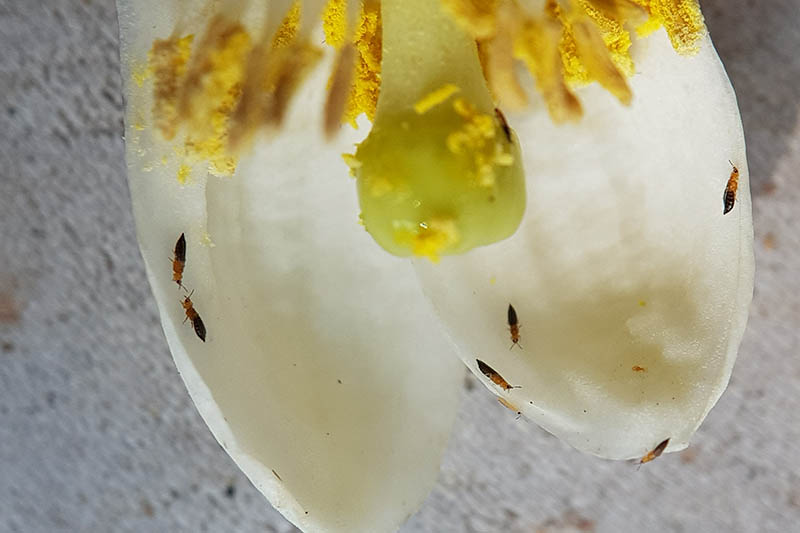

These insects are so small that you’ll need a hand lens to properly identify them.
While thrips won’t cause much direct damage to your plants, they can transmit viruses which can cause a lot of harm.
Learn more about identifying and controlling thrips in our guide.
Disease
You aren’t likely to find signs of disease among your cosmos, but in the rare event that you do, here are some the most likely problems you might encounter:
Aster Yellows
If your cosmos are infected with aster yellows, you’ll most likely notice deformed flower heads on your plants.
These deformations are caused by phytoplasmas spread by an insect, the aster leafhopper.
Since the only cure for aster yellows is prevention, it can be helpful to know what to look for and what steps to take to prevent it.
To learn how to prevent this disease as well as how to manage an existing infection, check out our article on aster yellows.
Powdery Mildew
Have you noticed large white or gray patches on the foliage? If so, powdery mildew may be to blame.
While patches of mildew on leaf tops are the first sign, affected leaves will eventually turn brown and shrivel up.
Risk of encountering this fungal disease is highest when the weather is humid at night and less so during the day. If you live in a humid climate, you can help prevent this disease by ensuring there is adequate airflow around your plants.
If infection has already set in, remove any infected leaves and dispose of them to prevent further spread.
Read our article to learn more about how to prevent powdery mildew, as well as how to and treat it using natural, homemade remedies.
Smut
Smut, another fungal disease, can make itself known in your ornamentals with the appearance of small yellow spots on foliage.
These spots will develop into pustules that eventually rupture, spreading fungal spores.
Smut is best prevented through good gardening habits such as allowing adequate spacing between plants, watering the soil surface instead of showering the tops of plants, and taking care to sanitize garden tools between uses.
You can learn more about smut in our article.
Best Uses
Cosmos can be used in the landscape in countless ways.
Use them as part of your landscaping plan for a tall, wispy floral accent or create mass plantings for a strong visual statement.
In mixed flower beds, plant tall varieties at the back of borders or as a central focal point, and use smaller varieties in the midground or foreground.
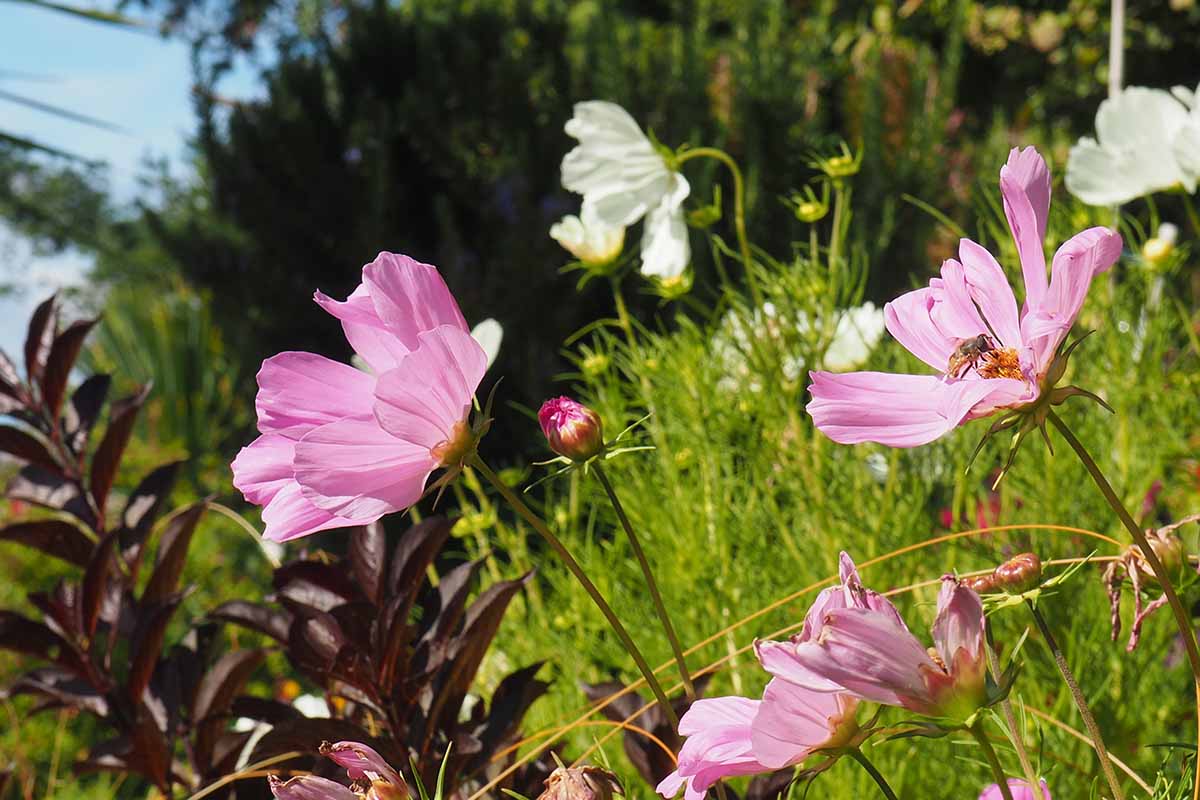

Taller varieties can also be used to create a vegetative screen.
For planters and containers, make sure to use dwarf varieties since full-sized specimens will crowd out the other plants, and their roots will dominate available soil.
Since they are easy to grow, these are a great option for children’s gardens, and they are also a welcome addition to butterfly gardens or cut flower gardens.
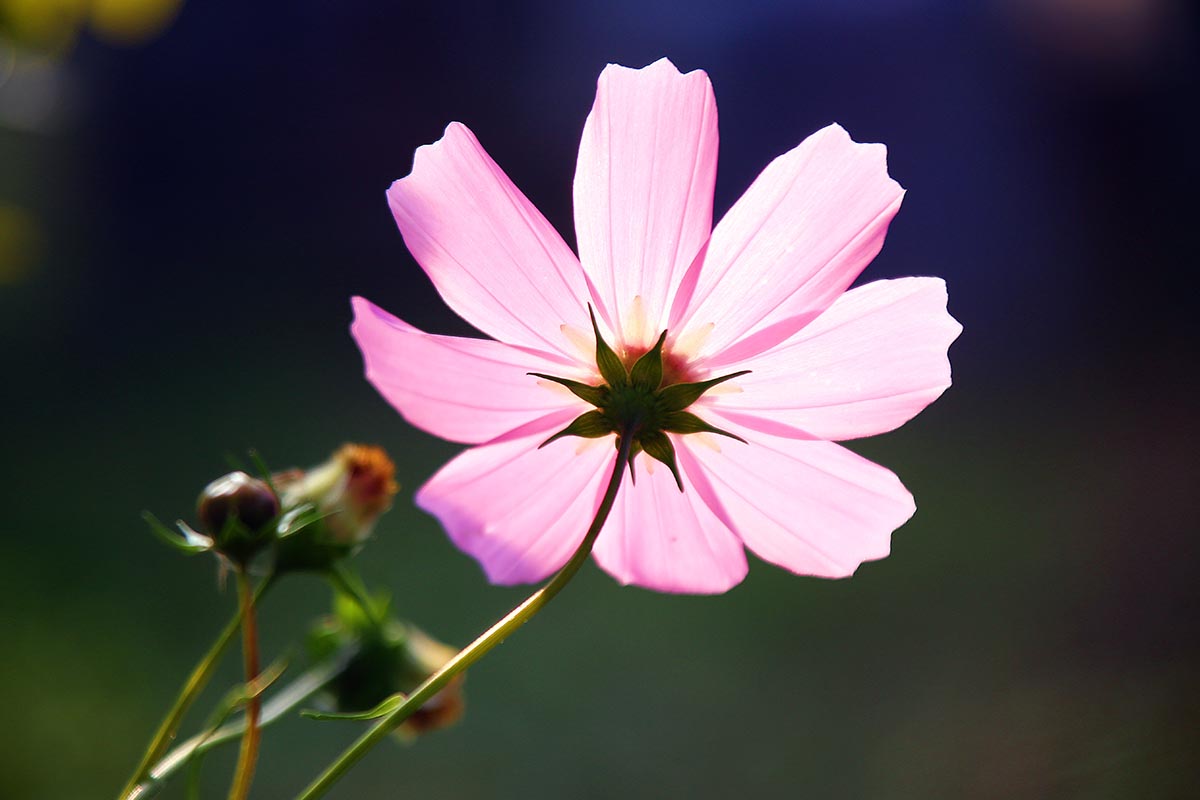

In the veggie garden, cosmos make valuable insectary plants to attract beneficial insects such as bees, predatory wasps, and hoverflies – and they can be grown as companion plants among vegetable crops such as artichokes, cabbage, or kale.
Blooming right up until the first frost, and sometimes longer, these flowers are excellent for late summer color.
Quick Reference Growing Guide
| Plant Type: | Herbaceous flowering annual | Flower/Foliage Color: | White, red, pink, purple, yellow, orange/green |
| Native to: | Central America | Maintenance: | Low |
| Hardiness (USDA Zone): | 2-11 (some varieties perennial in 9-11) | Tolerance: | Moderate drought tolerance when mature |
| Bloom Time: | Summer to fall | Soil Type: | Sand or loam |
| Exposure: | Full sun | Soil pH: | 6.0-8.0 |
| Time to Maturity: | 60-90 days, depending on variety | Soil Drainage: | Well-draining |
| Spacing: | 9-12 inches | Companion Planting: | Black-eyed Susans, coneflowers, dahlias, hollyhocks, marigolds, ornamental grasses, sweet peas, zinnias |
| Planting Depth: | 1/16 inch (seeds), depth of root ball (transplants) | Uses: | Butterfly gardens, children’s gardens, companion planting, cut flower gardens, insectaries, mass plantings, meadows, ornamental landscaping, pollinator gardens, vegetative screens |
| Height: | 1-6 feet | Attracts: | Bees, birds, butterflies, hoverflies, wasps |
| Spread: | 1-3 feet | Family: | Asteraceae |
| Water Needs: | Moderate | Genus: | Cosmos |
| Pests & Diseases: | Aphids, four-lined plant bugs, Japanese beetles, spider mites, stalk borers, thrips; Aster yellows, bacterial wilt, botrytis blight, leaf spot, powdery mildew, smut | Species: | Atrosanguineus, bipinnatus, sulphureus |
A Vision of Universal Beauty
We’ve covered all the basics of growing beautiful cosmos flowers, so how about a quick recap?
Grow these lovelies in full sun and in well-draining soil, water them judiciously, don’t over-fertilize – and be sure to take advantage of the many options available when growing cosmos from seed!
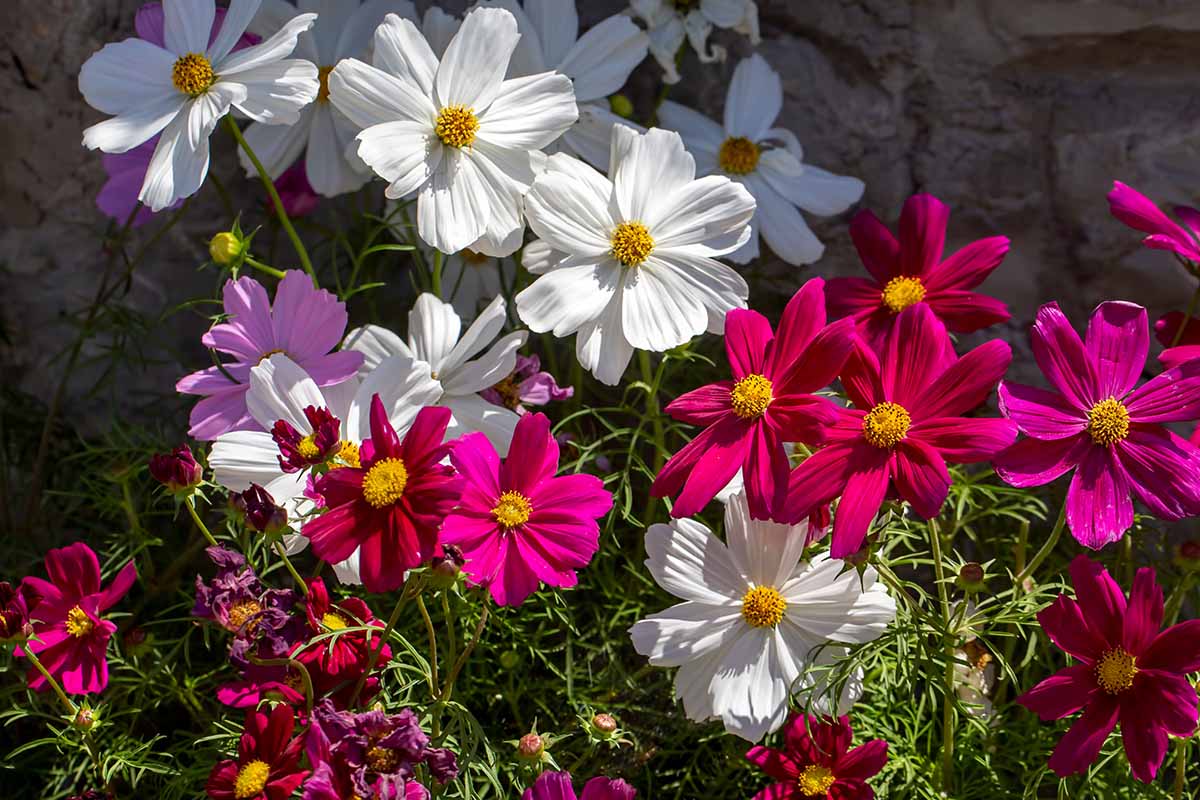

Are cosmos growing in your garden? Tell us about your experience with this flowering favorite in the comments section below.
And to learn about other annual flowers for your garden, check out these articles next:


